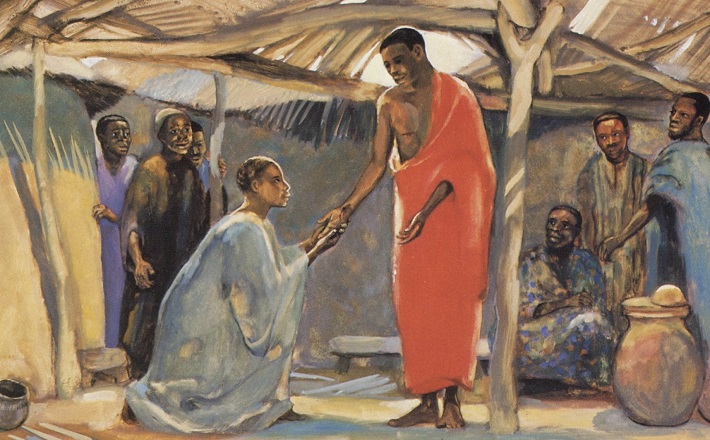Commentary on John 20:19-31
John 20 tells us that Jesus appeared to some of his most important disciples “on the first day of the week.”
First of all, to Mary Magdalene (20:11-18). Commissioning her as the Apostle to the Apostles, he commands her to proclaim the resurrection, which she does (“I have seen the Lord!”). He also tells her to proclaim the result of the resurrection — that the hearers of the gospel are now “children of God,” sharing the same Parent as Jesus, just as John started foreshadowing in 1:12-13.
To whom must she proclaim all of this good news? To Jesus’ adelphoi. The NRSV translates adelphoi as “brothers” in verse 17, but elsewhere they translate it “brothers and sisters,” correctly. Adelphoi is the word used if both males and females are present and it’s the word used if only males are present. There’s no reason to limit Mary’s audience to males. If one chooses to do so, it must be on grounds other than grammatical, linguistic ones.
Did Thomas hear her proclamation of the gospel?
Behind Closed Doors
Presumably “the disciples” (again, unspecific) we meet in verse 19 heard her at least. And what do the disciples do in response to Mary Magdalene’s proclamation of the risen Jesus, of abundant life, of a world forever changed and open with possibility? They hide in fear behind locked doors. Sound familiar? You might help your people ponder this narrated fact.
Note one of John’s favorite motifs: light versus darkness. Like the Samaritan woman, Mary Magdalene is a person of the day, the light, out in the Garden. Like Nicodemus, the disciples are huddled in the darkness that comes from “hiding out” for one reason or another.
As a “church” (they are, after all gathered disciples meeting where they usually met, verse 19), they have locked the doors out of fear (verse 19). Can your people relate to this? They have “enfortressed” themselves. I recall David Bartlett saying that: “We sing ‘A Mighty Fortress is our God,’ but what we mean is ‘A Mighty Fortress is our Church.’”
Jesus seeks out these unnamed disciples and meets them where they are, offering them peace in place of fear (verse 19). He shows them his hands and his side, and they know it’s Jesus. It never stops being the case that we have this treasure in clay jars, that we experience the world, both inner and outer, through our bodies. What do you make of the fact that the body of the risen Jesus still carries the marks of lived experience? Certainly, from a doctrinal perspective, it emphasizes that Jesus was really human and his body was essential to his personhood, and that the risen Christ is, in fact, Jesus of Nazareth. But what does it mean for you and your people at a more personal level?
He then reiterates (verse 21, palin, “again”) his offer of peace. As far as I’m concerned, he can never remind us enough. He also does to them what he did with Mary Magdalene earlier — he sends them on mission (apostello, pempo, verse 21). But Jesus never sends us without equipping us for it, spiritually. And I mean that literally. Just as he bestowed the Spirit on the newly formed church at the foot of the cross (19:31), he now breathes on them with the Holy Pneuma (spirit/breath). He then reminds them that with great power (the Holy Spirit) comes great responsibility (discerning God’s confrontation of sin and offer of forgiveness).
Demanding Thomas
Remember when we first met Thomas back in 11:16? Jesus was planning to head to Judea to raise Lazarus, and the disciples were trying to talk him out of it, since it was dangerous territory for Jesus. When I hear Thomas, I imagine the voice of Eeyore: committed, but in a resigned, underwhelmed, less-than-hopeful tone. Maybe you have parishioners like that? Maybe you are like that? in each case. Eeyore-Thomas makes his first appearance in the Gospel when he says in his forthright, resigned, if brave statement: “Let us also go, that we may die with him.”
Thomas next appears in 14:1, when Jesus is talking about his impending death and ascension to heaven. It’s unlikely that the other disciples have a clue about what Jesus is saying (suggested by his interaction with Philip in verse 9), but they remain silent. Not Thomas. He speaks up and says, “Well, actually, I have no idea what you’re talking about” (verse 5, my translation). Thomas is a straight shooter, a practical guy. He may not have much imagination or sense of mystery, but he does have an enquiring mind. Thomas asks the tough questions that others may be scared or embarrassed to ask. Thomas is a no-nonsense guy, and I can appreciate that. So maybe we shouldn’t be so surprised at what happens in John 20– Thomas stays in character.
When Jesus appears to the disciples in the locked room, where’s Thomas? The text doesn’t say, so we are free to imagine where he is, what he’s doing, and what he may be thinking and feeling, based on what we know about Thomas. We don’t know where his friends find him, but they tell him the news. And how does Thomas react? Is he overjoyed and comforted? No. He reacts just as the disciples do when Mary tells them the same thing. Are they overjoyed? Do they run out to the garden to find Jesus? No, Jesus the Good Shepherd must find his sheep.
Thomas then makes his dramatic statement: “Unless I see the mark of the nails in his hands and shove my finger into the mark of the nails, and shove my hand into his side, I absolutely will not believe” (20:25, my translation). The verb is a forceful one (ballo), as is the emphatic negative (ou me). Not a simple, “I’ll believe it when I see it” –Thomas has lot of conditions. And this may make him relatable for the people you preach to and for. He puts conditions on his faith. He wants hard evidence, unquestionable eyewitness fact that Jesus is risen. I can’t blame him. You know why? Two reasons: First, he’s asking to see at least what all the other disciples already saw. Second, who doesn’t love a solid sign in a moment of crisis and vulnerability? No, I can’t blame Thomas. So, what happens?
Believing Thomas
Eight days after Thomas makes this pronouncement, his wish comes true. And then some. Jesus appears and speaks directly to Thomas. Scripture doesn’t tell us that Thomas ever even touched the wounds. Again, you are free (invited, required?) to use your imagination. Once Thomas got a look at and felt the presence of the risen Lord, perhaps he forgot all his conditions. Perhaps the only thing he could spit out was, “My Lord and my God.” In other words, perhaps the presence of the risen Lord blotted out Thomas’s petty skepticisms and puny proofs and arrogant arguments. This was the glory of the risen Lord, and the only appropriate response was to confess him as Lord and God.
And that’s another reason I like Thomas. He knew when he was beat. He knew there was a time to shut up and bow down. In my eyes, Thomas was blessed, and maybe I’m a little envious that he got such a wonderful opportunity. But you know what Jesus says? He says to Thomas, “Have you believed because you have seen me (reread John 2:23–25 and 4:48 to see that John is quite impatient with those who need signs and wonders to believe and follow Jesus)? Blessed are those who have not seen and yet have come to believe.” That, of course, includes at least the reader of John’s Gospel, including you and your people.
Conclusion
In Thomas, we see the pattern of Christian discipleship established from the beginning of John 1. One person encounters Jesus. Then they share their experience with the next person, who may express some reluctance. Then that person experiences Jesus on their own, directly, and becomes convinced about him and then shares the news about Jesus with the next person. Andrew tells Peter. Philip tells Nathanael. The Samaritan woman tells the townspeople. “Come and See” is the refrain.
With respect to the witness of the resurrected Jesus, Mary Magdalene starts it off. She encounters Jesus, shares the news; the others don’t really buy it until they have their own experiences so that they can own the experience. They become convinced and then share it with Thomas. Like the other disciples, Thomas doesn’t come to the fullest faith until he has his own experience. I say fullest faith, because he already has faith. The text says, “Don’t become a faithless person” (my translation). Move from where you are to the next level.
Scholars debate whether Thomas has faith beforehand or not. The debate centers on how to interpret the second person singular imperative, me ginou — it can mean either “do not be without faith (apistos)” do not continue to be without faith (with a durative emphasis), or “do not become without faith” (with an ingressive emphasis). I, with others, argue for the latter. You, the preacher, have wiggle room here.
Then the story moves through the chain, and you, your people, and I are up next. Thomas makes his confession and, through this text, testifies to us. Now what will we do? Will we hang in there with some level of interest and commitment until we encounter Jesus in a way that moves us to the next level? What would the next level look like for us, understanding that we are all in very different places? For the author, the highest level is living abundantly. Are we there yet?
In the end, it’s not Thomas’s “doubting” or demanding that matters; it’s his believing. Everybody doubts; not everyone believes. Be a believing Thomas; push as hard as you need to until you are awestruck and moved to proclaim with him: “My Lord and my God!”
Notes:
This essay is an adaptation of chapter 15 of Jaime Clark-Soles’ new book Reading John for Dear Life: A Spiritual Walk with the Fourth Gospel. Louisville: Westminster John Knox Press, 2016.


April 23, 2017